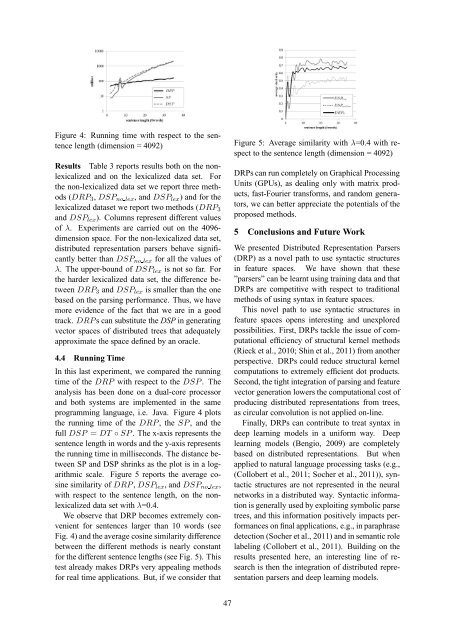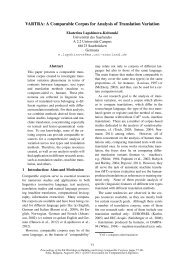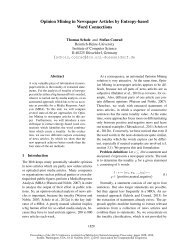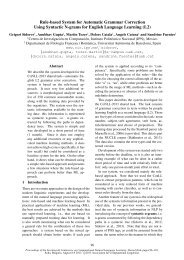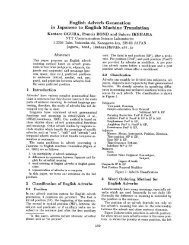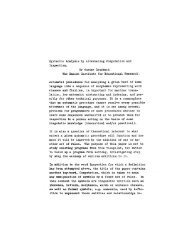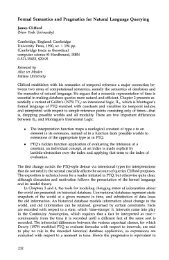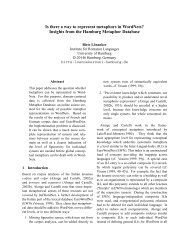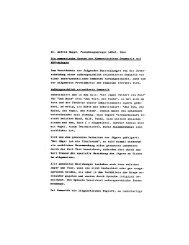Vector Space Semantic Parsing: A Framework for Compositional ...
Vector Space Semantic Parsing: A Framework for Compositional ...
Vector Space Semantic Parsing: A Framework for Compositional ...
You also want an ePaper? Increase the reach of your titles
YUMPU automatically turns print PDFs into web optimized ePapers that Google loves.
Figure 4: Running time with respect to the sentence<br />
length (dimension = 4092)<br />
Results Table 3 reports results both on the nonlexicalized<br />
and on the lexicalized data set. For<br />
the non-lexicalized data set we report three methods<br />
(DRP 3 , DSP no lex , and DSP lex ) and <strong>for</strong> the<br />
lexicalized dataset we report two methods (DRP 3<br />
and DSP lex ). Columns represent different values<br />
of λ. Experiments are carried out on the 4096-<br />
dimension space. For the non-lexicalized data set,<br />
distributed representation parsers behave significantly<br />
better than DSP no lex <strong>for</strong> all the values of<br />
λ. The upper-bound of DSP lex is not so far. For<br />
the harder lexicalized data set, the difference between<br />
DRP 3 and DSP lex is smaller than the one<br />
based on the parsing per<strong>for</strong>mance. Thus, we have<br />
more evidence of the fact that we are in a good<br />
track. DRP s can substitute the DSP in generating<br />
vector spaces of distributed trees that adequately<br />
approximate the space defined by an oracle.<br />
4.4 Running Time<br />
In this last experiment, we compared the running<br />
time of the DRP with respect to the DSP . The<br />
analysis has been done on a dual-core processor<br />
and both systems are implemented in the same<br />
programming language, i.e. Java. Figure 4 plots<br />
the running time of the DRP , the SP , and the<br />
full DSP = DT ◦SP . The x-axis represents the<br />
sentence length in words and the y-axis represents<br />
the running time in milliseconds. The distance between<br />
SP and DSP shrinks as the plot is in a logarithmic<br />
scale. Figure 5 reports the average cosine<br />
similarity of DRP ,DSP lex , and DSP no lex ,<br />
with respect to the sentence length, on the nonlexicalized<br />
data set withλ=0.4.<br />
We observe that DRP becomes extremely convenient<br />
<strong>for</strong> sentences larger than 10 words (see<br />
Fig. 4) and the average cosine similarity difference<br />
between the different methods is nearly constant<br />
<strong>for</strong> the different sentence lengths (see Fig. 5). This<br />
test already makes DRPs very appealing methods<br />
<strong>for</strong> real time applications. But, if we consider that<br />
Figure 5: Average similarity with λ=0.4 with respect<br />
to the sentence length (dimension = 4092)<br />
DRPs can run completely on Graphical Processing<br />
Units (GPUs), as dealing only with matrix products,<br />
fast-Fourier trans<strong>for</strong>ms, and random generators,<br />
we can better appreciate the potentials of the<br />
proposed methods.<br />
5 Conclusions and Future Work<br />
We presented Distributed Representation Parsers<br />
(DRP) as a novel path to use syntactic structures<br />
in feature spaces. We have shown that these<br />
”parsers” can be learnt using training data and that<br />
DRPs are competitive with respect to traditional<br />
methods of using syntax in feature spaces.<br />
This novel path to use syntactic structures in<br />
feature spaces opens interesting and unexplored<br />
possibilities. First, DRPs tackle the issue of computational<br />
efficiency of structural kernel methods<br />
(Rieck et al., 2010; Shin et al., 2011) from another<br />
perspective. DRPs could reduce structural kernel<br />
computations to extremely efficient dot products.<br />
Second, the tight integration of parsing and feature<br />
vector generation lowers the computational cost of<br />
producing distributed representations from trees,<br />
as circular convolution is not applied on-line.<br />
Finally, DRPs can contribute to treat syntax in<br />
deep learning models in a uni<strong>for</strong>m way. Deep<br />
learning models (Bengio, 2009) are completely<br />
based on distributed representations. But when<br />
applied to natural language processing tasks (e.g.,<br />
(Collobert et al., 2011; Socher et al., 2011)), syntactic<br />
structures are not represented in the neural<br />
networks in a distributed way. Syntactic in<strong>for</strong>mation<br />
is generally used by exploiting symbolic parse<br />
trees, and this in<strong>for</strong>mation positively impacts per<strong>for</strong>mances<br />
on final applications, e.g., in paraphrase<br />
detection (Socher et al., 2011) and in semantic role<br />
labeling (Collobert et al., 2011). Building on the<br />
results presented here, an interesting line of research<br />
is then the integration of distributed representation<br />
parsers and deep learning models.<br />
47


